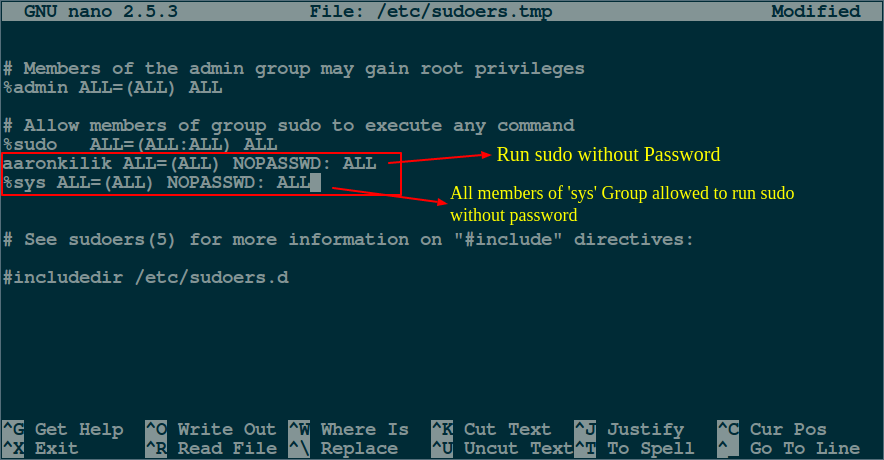

- #Allow user to sudo without password how to#
- #Allow user to sudo without password update#
- #Allow user to sudo without password full#
- #Allow user to sudo without password password#
If you have already edited your /etc/sudoers file, either return it to its original unedited state and use the 10-installer file for configuration, or delete the /etc/sudoers.d/10-installer file and use the direct edits to the /etc/sudoers instead. to allow all users to run all commands without a password.
#Allow user to sudo without password password#
Add the following line to disable the sudo password for a specific user. This can be accomplished with the following command: Scroll down to the bottom of the file, where we will be adding a line.


Start by opening a command line terminal and editing the /etc/sudoers file.
If you want to enable passwordless sudo privileges for the wheel group, change that line to: Allow Sudo Command Without Password step by step instructions. The sudo command can be run without a password by modifying the sudoers file script withThe 10-installer file gives sudo privileges to all members in the wheel group. pacnew file (.pacnew files must be handled - carefully - by the user).ĭrop-in files for sudoers can also make management of multiple users easier if there are a number of users on the system.
#Allow user to sudo without password update#
This has the advantage of the system being able to update the original file (to add new features, new syntax, etc) without creating a. Notice the last line of /etc/sudoers: # Read drop-in files from /etc/sudoers.dĭrop-in files allow modifications to the default configuration of a file without physically editing the file itself. Create a rule as such: ALL ALL (ALL:ALL) NOPASSWD: /bin/mkdir The ending set of quotes tells sudo not to. The sudo -s command grants the user a Sudo shell. The /etc/sudoers.d/10-installer file is a drop-in file used for configuration. Method 1 running sudo commands without password temporarily The easiest way to run sudo commands without a password is to do it temporarily meaning no editing to the system files to change settings. Well, it’s granting sudo privileges to all members of the wheel group, which is at least a little special. 'ssh -i /home/ yourlocalusername/.It seems to not be doing anything special It is also important to use the -e swtich as above if you are depending on a key to login (which most will be): The policy may require that users authenticate themselves with a password or. When you run a command with sudo, it asks for your account’s password. The security policy determines what privileges, if any, a user has to run sudo. Sudo rsync -e 'ssh -i /home/ yourlocalusername/.ssh/id_rsa' -rsync-path="sudo rsync" -Phaz /remote/path /local/path Most Linux distributions like Ubuntu, Debian, Fedora use the sudo mechanism to allow admin users to run commands with root privileges. To run rsync locally with root privileges you also need to start it with "sudo rsync" as shown below. 216 Preface This is a fairly complex question related to the sudoers file and the sudo command in general. As a result, non-root users can enter such commands without logging in to the root user account.
#Allow user to sudo without password how to#
This (above) executes rsync on the remote host as root. Managing sudo access System administrators can grant sudo access to allow non-root users to execute administrative commands that are normally reserved for the root user. linux - How to allow a normal user to kill a certain root application in visudo with no password - Stack Overflow I wanna allow a normal user to kill a certain application which is started by root user. The key thing for the remote host is to use: Yourusername ALL = NOPASSWD: /usr/bin/rsync To grant another user, fred lets say, password-less access to sudo, use visudo to add a rule to the end of the sudoers file. You can actually just give them passwordless sudo access to rsync in /etc/sudoers:
#Allow user to sudo without password full#
This is a common issue, what if a issue shouldn't have root but you want to use that user to make a full backup of a system? They of course need root access. Edit the /etc/sudoers file on CentOS: sudo visudo Run /usr/sbin/rebootcommand without password on CentOS: marlena ALL NOPASSWD: /usr/bin/reboot Save and exit the file.


 0 kommentar(er)
0 kommentar(er)
